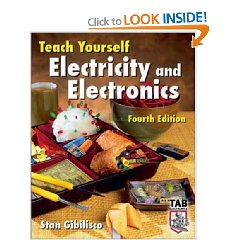The other day I needed to build a circuit to bump 3v up to something between 3.5 and 5 for my CHDK Remote Cable hack. I looked up a handful of schematics for circuits that do this… and realized I didn’t really understand what any of them were doing. At least not well enough to appropriate the circuit for my own needs.
I took Electricity and Magnetism second semester of my senior year of high school. Which is to say I don’t remember any of it. So I figured it was time I actually learn the math behind the electrical circuits I’m building instead of sticking things together haphazardly to see if they work. I remember how to use V=IR, but that doesn’t really answer the question “how do I bump 3v up to 3.5v?”
I’m reading “Teach Yourself Electricity and Electronics” , so far I’m just as far as some basic concepts of DC and AC power. Of course I almost never do anything with AC power, but I suppose it’s handy to know.
The book itself is pretty dry. But it’s an electronics book, so I suppose any of them are going to be dry. If there are any other good basic electronics theory I’d love to hear them. On the plus side, this one is great for getting me to sleep.

“Getting Started in Electronics” by Forrest Mims is another great book for learning about electricity and common electronic components. Everything is handwritten and hand-drawn so I personally don’t find it very boring at all.
On another note, if you want to boost from 3V to 3.5-5V you may want to look into building a step-up circuit (DC-to-DC converter). An IC and inductor is usually involved. Maxim sells lots of chips that do just this and you may even be able to get one as a sample.
The Art of Electronics by Paul Horowitz, Winfield Hill is pretty good. It’s more practical/less theoretical than the books I had in EE classes in college, and some of the things I never grasped from those became a lot clearer once I had read this book.
http://books.google.com/books?id=bkOMDgwFA28C
A voltage booster works by running a current through a coil, and then stopping it suddenly. The current has “inertia” going through the coil (actually due to magnetic fields), so at the point where the cut is made, charge builds up, increasing the voltage. When the voltage increases high enough, you let it overflow to the output and then pulse the coil again. It’s kind of like a hydraulic ram pump.
http://en.wikipedia.org/wiki/Hydraulic_ram
You can also charge up two capacitors to the same voltage, disconnect them, and then connect them in series to double the voltage. This is the basic idea behind charge pump voltage boosters, which use FET switches to repeatedly connect and disconnect “flying capacitors” to produce a higher output voltage than the input.
you need a buck/boost chip/circuit to do it. DC is hard to change voltages, which is one of the reasons the “mains” power is AC.
Or google for switching power supplies.
Its a lot easier to drop voltage from 5 or 6V down to 3.5 than to raise something. So think about using four AA cells.
I had “Getting Started in Electronics” as a kid, and tried to teach myself electronics with it, but I think it mislead me more than anything. I don’t recommend it:
http://www.goodreads.com/review/show/44919448